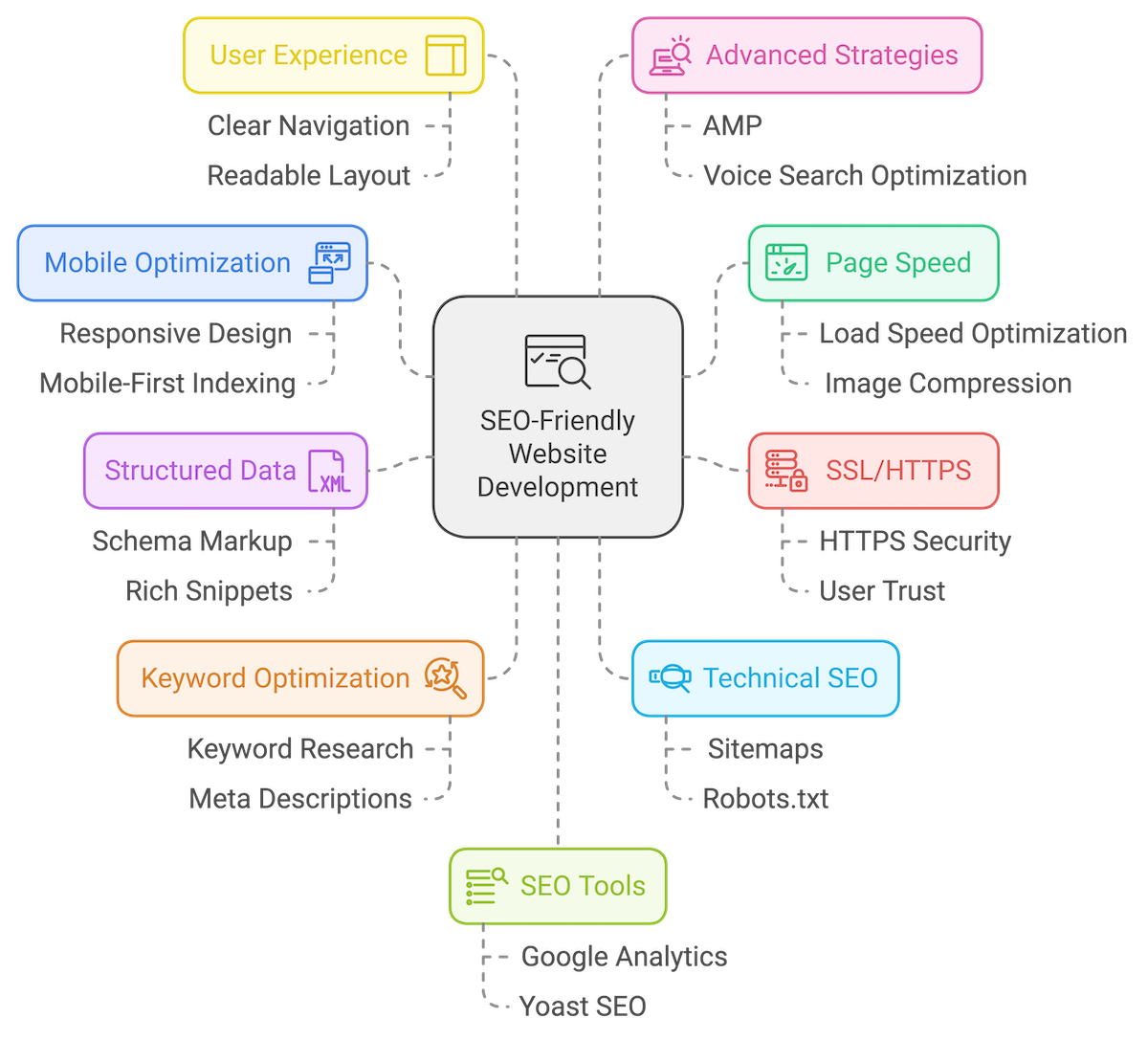SEO-Friendly Website Development: Mastering the Essentials
By: Hayden Jarman

Building a website optimized for search engines is crucial for businesses aiming to improve online visibility and attract more customers.
Creating an SEO-friendly site is no longer optional in an environment where 54.67% of global website traffic comes from mobile devices.
A strategic approach to web development, focusing on speed, security, and content, can help reduce bounce rates, drive organic traffic, and keep users engaged.
Table of Contents:
- Why SEO-Friendly Website Development Matters
- Key SEO Factors
- SEO-Friendly Keywords and Content Optimization
- Data-Driven SEO-Friendly Features
- Technical SEO Essentials
- Enhancing User Experience (UX)
- Advanced Strategies for SEO-Friendly Development
- Key SEO-Friendly Development Tools
- Common Pitfalls to Avoid
- Tips for Creating SEO-Friendly Content
- Benefits of an SEO-Friendly Website
- Tracking SEO Performance
- Final Thoughts
🚀 How SEO-Friendly Is Your Website? 🔍
Test your SEO knowledge and get personalized tips to improve your website’s search performance.
Why SEO-Friendly Website Development Matters
Today’s digital ecosystem emphasizes mobile responsiveness, speed, and user experience.
Google and Bing prioritize websites that excel in these areas, rewarding them with better search engine rankings. For businesses, developing an SEO-friendly site means adapting to these factors and staying ahead of the competition.
Optimizing for SEO includes:
- Responsive Design: Your site needs to adjust smoothly to various screen sizes. Mobile-first indexing by Google means websites that aren’t mobile-friendly lose valuable traffic.
- Page Speed Optimization: Slow-loading pages are a major turn-off for users. A delay of just 1 to 3 seconds increases bounce rates by 32%.
- SSL and HTTPS: Websites secured with HTTPS rank higher, with 70.4% of voice search results linked to HTTPS sites.
Learn More: Discover how to enhance lead quality through SEO improvements.
Key SEO Factors
Mobile Optimization
Mobile optimization remains critical, especially as over half of all traffic now comes from mobile devices.
Google’s preference for mobile-friendly sites means responsive design is no longer a “nice-to-have”—it’s a requirement.
Structured Data and Schema Markup
Using structured data helps search engines understand your content and increases the chances of appearing in rich snippets.
With only 36.4% of voice search results using Schema markup, there’s a significant opportunity to improve visibility.
SEO-Friendly Keywords and Content Optimization
Implementing keywords like “SEO best practices” and “content optimization” strategically across your website is essential.
But keyword stuffing should be avoided.
Here’s how to integrate keywords naturally and effectively:
- Keyword Research: Use tools such as SEMrush and Google Keyword Planner to identify high-impact keywords relevant to your audience.
- Meta Descriptions and Titles: Google rewrites 62.78% of meta descriptions to align with user queries. Craft concise, accurate descriptions, as 33% of title tags are rewritten, particularly when they exceed character limits.
Optimize Your Content: Explore top strategies for content optimization.
Data-Driven SEO-Friendly Features
Leveraging data is essential in shaping a successful SEO strategy.
Here’s a breakdown of SEO factors and their impact:
| SEO Factor | Impact | Supporting Data |
|---|---|---|
| Page Load Speed | Reduces bounce rates | 32% decrease in bounces |
| Mobile Optimization | Expands accessibility | 54.67% of traffic is mobile |
| HTTPS Security | Builds user trust | 70.4% of voice search pages are HTTPS |
| Long-Form Content | Boosts backlinks | 77.2% more backlinks for long content |
Technical SEO Essentials
Sitemaps
XML sitemaps guide search engines in crawling and indexing your website.
An updated sitemap can significantly improve crawl efficiency, especially for larger sites.
Robots.txt
The robots.txt file controls which parts of your site search engines should and shouldn’t crawl.
Keeping certain pages out of the index can concentrate SEO efforts on high-value content.
Canonical Tags
Using canonical tags ensures that search engines treat a single URL as the primary version of a page, preventing duplicate content issues that could dilute ranking authority.
Build Authority: Learn about effective topical authority-building strategies.
Enhancing User Experience (UX)
User experience directly impacts SEO. Sites that are easy to navigate, load quickly, and display information effectively often retain users longer and improve overall engagement.
- Clear Navigation: Make navigation straightforward, keeping essential information accessible without clutter. For a deep dive, see our tips on improving website navigation for SEO.
- Load Speed: Optimize image sizes, reduce HTTP requests, and minimize plugins to speed up load times.
- Readable Layout: Use accessible fonts and adequate line spacing to maintain readability across devices.
Advanced Strategies for SEO-Friendly Development
Accelerated Mobile Pages (AMP)
AMP is a framework that enhances page speed for mobile users, increasing visibility in mobile search results.
While not required for all websites, AMP can benefit sites with a heavy mobile audience.
Voice Search Optimization
Optimizing for voice search includes using natural language and question-based keywords.
Structured data further enhances voice search results, making it easier for search engines to interpret content.
URL Structure
A clean URL structure aids both users and search engines.
Avoid URLs with unnecessary parameters and opt for descriptive, keyword-rich URLs.
| Bad URL | Good URL |
|---|---|
| /category?id=123 | /category/product-name |
| /products/567 | /products/green-t-shirt |
Key SEO-Friendly Development Tools
Choosing the right tools is essential to streamline SEO efforts.
Here are some must-have SEO tools:
- Google Analytics: Tracks and reports on visitor behavior, helping to understand what content resonates most.
- Google Search Console: Provides insights into your site’s performance in search results.
- Moz Pro and Ahrefs: Offer keyword research, backlink analysis, and site audits to boost SEO.
- Yoast SEO: A go-to plugin for on-page optimization, especially useful for WordPress sites.
Leverage Data: Find out how to use Google Analytics effectively for tracking SEO metrics.
Common Pitfalls to Avoid
Steering clear of common mistakes ensures stronger SEO performance.
Watch out for these pitfalls:
- Ignoring Mobile Optimization: With mobile traffic dominating, mobile optimization should be a priority.
- Keyword Stuffing: Incorporate keywords naturally to avoid penalties.
- Neglecting Meta Tags: Meta descriptions and titles influence click-through rates, so don’t overlook them.
- Slow Loading Speed: Fast loading times reduce bounce rates, so minimize image file sizes and excessive code.
Further Reading: Check out these SEO optimization strategies.
Tips for Creating SEO-Friendly Content
Content remains central to an SEO-friendly website.
Here are some strategies for content that aligns with SEO goals:
- Focus on Long-Form Content: Long-form content generates 77.2% more backlinks, boosting authority and relevance.
- Add FAQs: Including FAQs can help capture voice search queries and improve engagement.
- Utilize Structured Data: Adding structured data helps content appear in rich snippets, enhancing visibility.
- Use Visuals: Incorporating images, charts, and tables can make content more engaging and increase time-on-page metrics.
Create Evergreen Content: Explore our guide on evergreen SEO content strategies.

Benefits of an SEO-Friendly Website
Developing a site optimized for SEO offers multiple advantages beyond search engine rankings.
- Increased Organic Traffic: SEO drives over 1,000% more traffic than organic social media, highlighting its potential as a long-term strategy.
- Higher Conversion Rates: SEO-friendly, user-focused websites typically see improved conversion rates.
- Enhanced Brand Authority: Higher search rankings increase credibility, making users more likely to trust your brand.
- Cost-Effective Marketing: Once established, SEO-driven traffic remains steady, reducing reliance on paid advertising.
Learn More: For a deep dive into SEO benefits, visit our post on content marketing for sales.
Tracking SEO Performance
Measuring SEO performance is essential for evaluating your efforts.
Track these key performance indicators (KPIs) to gauge success:
| Metric | Importance |
|---|---|
| Organic Traffic | Measures reach of SEO efforts |
| Bounce Rate | Indicates user engagement |
| Conversion Rate | Reflects effectiveness of content |
| Page Load Time | Impacts bounce rate and conversions |
Learn More: Read our guide on setting up conversions to better understand user behavior.
Final Thoughts
Building an SEO-friendly website demands a careful balance between technical SEO, content strategy, and UX design.
By focusing on essentials like mobile optimization, HTTPS security, structured data, and effective content, you’ll boost your site’s visibility and reach in search engines.
Utilize the tools and data-driven insights we’ve covered to keep your website competitive. And as search engine algorithms continue to evolve, regularly updating and refining your approach ensures long-term success.
This post empowers you to take actionable steps in developing an SEO-friendly website.
By integrating these strategies, your website can achieve sustainable growth, attract more organic traffic, and enhance your brand’s authority.
Related Posts:
- Understanding Google’s Local Pack: How to Get Featured
- Google Business Profile FAQs: Everything You Need to Know
- The Best Google Ads Extensions to Boost Your Click-Through Rates
- How to Leverage Facebook Groups for Local Business Leads
- How to Use AI to Write Better Social Media Captions
- How to Optimize Google Reviews to Attract More Customers
- LinkedIn for B2B Marketing Success
- How to Conduct a Social Media Audit (w/ "Audit Readiness" Quiz!)
- Creating a Content Calendar for Consistent Posting
- The Importance of Mobile Optimization in 2024
- Data Privacy Regulations: What Marketers Need to Know
- The Role of Chatbots in Enhancing Customer Service
- SEO for Small Business: The Ultimate Guide to Getting Found Online
- The Role of Keyword Clustering in Modern SEO

